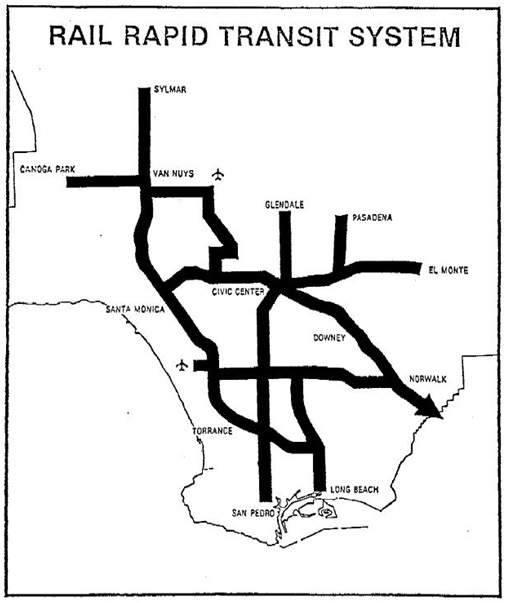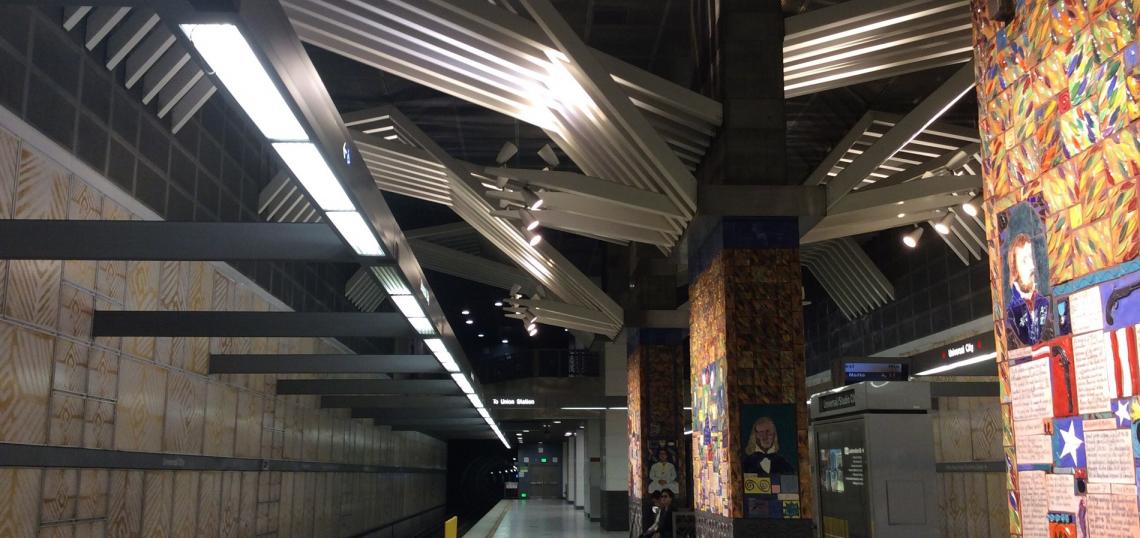On Thursday, Metro’s Board of Directors received updates on the Bus Rapid Transit project that would improve a 12-mile corridor between Los Feliz and the Century Freeway. Near-term improvements for this stretch could include dedicated bus lanes, and, where the street is particularly wide, center-running operations that could significantly increase the operating speeds of 204 and 754 buses. This project is funded by Measure M, and it represents a significant step forward from the status quo. If there is a criticism, it is, as I have said previously, that Vermont has sufficient promise and need to justify moving aggressively to implement rail in addition to speeding up bus service. This approach, in my opinion, befits Vermont’s status as a lynchpin of regional transit, and a lifeline for riders from some of the county’s poorest neighborhoods. Happily, it seems that this view is also shared by some of Metro’s directors.
Directors Garcetti, Dupont-Walker and Ridley-Thomas offered a joint motion to initiate the study process for extending the Red Line south on Vermont toward the Century Freeway, with a three-mile extension between Wilshire and Exposition Park as a potential first phase. The three directors spoke of the regional importance of the project. Director Ridley-Thomas called the Vermont Subway a “missing link” in Los Angeles’ network, and suggested that on the strength of its merits the project might be able to be accelerated, even though there is no dedicated funding source for it as yet. “It seems to me,” he said, “we must be strategic, practical in our planning, and the rail that is needed, we should see that it comes to fruition. If we do that, I am absolutely sure that this particular corridor will move forward and move up.” The motion, which was approved by the board, also directs Metro staff to include a Red Line extension in the Alternatives Analysis and Environmental Impact Report for Measure M’s “Vermont Transit Corridor” line item, which was assumed to be a bus project up until now.
While the board’s action does not guarantee anything regarding the future of a Red Line extension on Vermont, it is an important first step to making the subway a reality. When the original Proposition A sales tax was brought before county voters in 1980, a corridor following Vermont Avenue and the 110 freeway was proposed as one of 10 for Los Angeles’ rail future. Nearly 40 years later, not only is there no rail on this stretch of Vermont, but there has never even been a thorough plan for its implementation. For a variety of reasons, the project has fallen repeatedly by the wayside. As Mayor Garcetti noted, Metro has been aware of its significance, including it as an unfunded priority in 2009’s Long Range Transportation Plan. However, when it came time to select projects for Measure M, the Red Line extension was left out in the cold. Metro’s newest funding stream will provide no new money for a rail project on Vermont until after 2067.

The reversal by the board, in deciding to study a heavy rail alternative, is laudable. Metro’s report projected that Bus Rapid Transit on Vermont would attract 75,000 daily riders, a total which is higher than all but a handful of Measure M projects. Impressive as that figure is, it is worth considering how many more riders would be served, and how many customer-hours would be saved, by choosing the subway option for this strong corridor. As a result of Thursday’s vote, we will eventually get full cost and ridership profiles for both the “short subway” corridor from Wilshire to Expo Park and for the full 10-mile stretch down to the border of Gardena.
The study will give Metro the opportunity to assess potential funding sources for the project. As I mentioned in my previous post, the ability for heavy rail to be built in an elevated alignment south of Gage not only makes construction cheaper, but it also allows Metro to consider using bonds from Propositions A and C to help fund the southernmost 4 miles of the project. Those funds, which are forbidden from use on below-grade rail, do not have a defined expenditure list, and so might be more maneuverable than money from Measures R and M. Directors Dupont-Walker and Garcetti each mentioned the renewed financial interest in the corridor, and particularly in the USC area. Director Dupont-Walker in particular called it “important, timely and urgent” that major institutions along the corridor partner with Metro to see through improvements to transit on Vermont including the possible implementation of rail. Indeed, the university, along with the newly-committed Museum of Narrative Art and a new professional soccer team, could each potentially have a financial interest in the Red Line extension as presently proposed.
There will be technical challenges to the rail option too, which will be addressed in any new study. The Wilshire/Vermont station, with inbound Red trains on the top platform and all outbound trains on the bottom floor, poses a unique challenge to disentangling Metro’s two heavy rail lines. Staff will likely come back with a handful of alternatives for a new transfer between the Red and Purple Lines, some of which might require an extensive rebuild of the existing station.
The board will also probably have to decide whether to retain any link between Red Line and Purple Line tracks, such as would allow for branch service from North Hollywood to Downtown, or for the continued use of the Division 20 maintenance yard in the Arts District by Red Line trains. While there will undoubtedly be some grousing from Red Line patrons north of Wilshire that they are being forced to make a new transfer in order to get downtown, the benefits of separating the lines entirely outweigh the inconveniences to this subset of riders.
Prominent among the reasons to pursue full separation as a matter of good transit provision is that it will allow Metro to run higher frequency service on the Purple Line, which, as it matures, will almost certainly grow into Metro’s highest ridership service. As currently planned, the Purple Line will run every four minutes during peak hours, but it could run every two minutes if it were not sharing track with the Red Line in DTLA. In truth, the trunk for this service should be considered the segment between Wilshire/Westwood and Union Station, which is where the most concentrated demand occurs. The difference between two- and four-minute headways might seem a small thing today, but in future decades a four-minute maximum frequency will likely be a severe limitation on capacity for Metro’s fastest crosstown option.
For Vermont, the subway will also increase frequencies, and significantly ease transit trips for riders in some of the county’s densest and most impoverished neighborhoods. The short subway would be a significant infill project, providing access to inner-ring suburbs like Pico-Union and Koreatown that would facilitate their further growth. There is no guarantee that the Red Line will ever extend south past Wilshire, but this study should be seen as a solid first step. If Metro’s directors remain interested in seeing “strategic, practical” rail planning, I’m hopeful that the full-length Red Line might finally make it off the drawing board.
Scott Frazier is a graduate student at Cal State University Los Angeles in Public Administration. Follow him on Twitter @safrazie.
- A Look at the Proposed Vermont BRT Line (Urbanize LA)
- Why the Vermont BRT Line Should be Rail (Urbanize LA)






